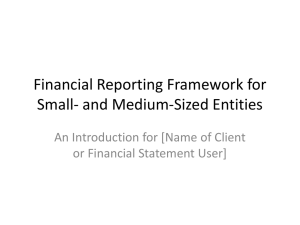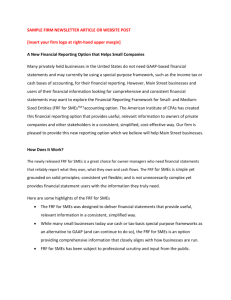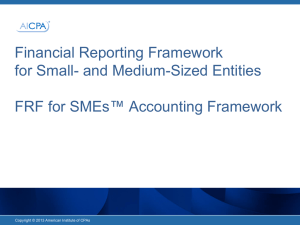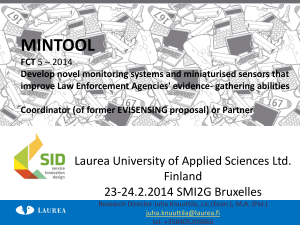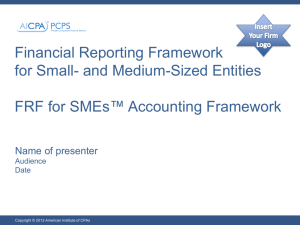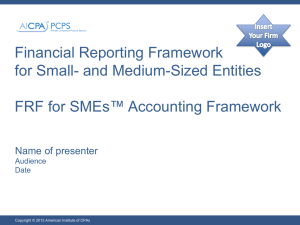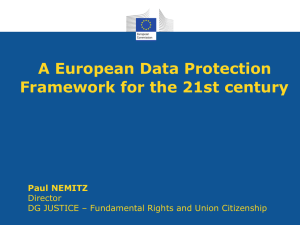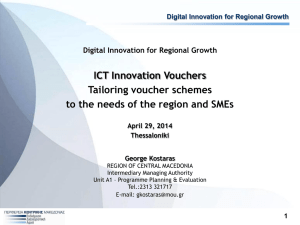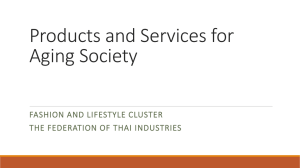FRF for SMEs™ PowerPoint to Introduce Framework to
advertisement
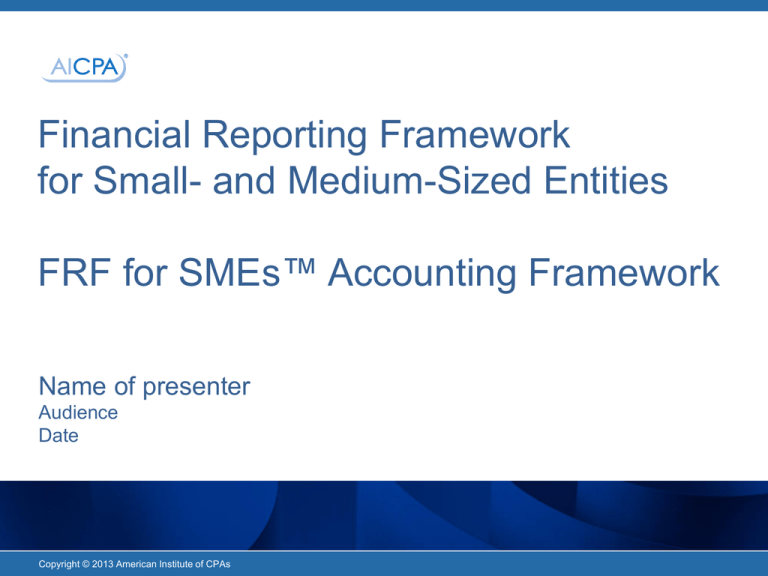
Financial Reporting Framework for Small- and Medium-Sized Entities FRF for SMEs™ Accounting Framework Name of presenter Audience Date Copyright © 2013 American Institute of CPAs America’s Main Street businesses MILLIONS of small- and mediumsized entities in the United States Small- and medium-sized entities pervade the business world and form the backbone of the US economy They provide goods and services in a wide-range set of activities and are active in many industry groups No standard definition of SME in US Current SPF reporting environment Special Purpose Frameworks (OCBOA): US GAAP Not Required GAAP not required and not the best solution for many small- and medium-sized entities IFRS for SMEs Lack of familiarity, higher learning curve, not US-centric, form of GAAP Other Special Purpose Frameworks Tax or modified cash basis may be inappropriate or insufficient for some SMEs/users Another option… ? ... a framework to help you deliver tailored financial reporting for America’s small business community … a framework with streamlined, common-sense requirements based on traditional and proven accounting methods … a framework to provide robust, meaningful financial reports to business owners, lenders, insurers and others without needless complexity It’s here An additional non-GAAP framework FRF for SMEs overview Responsive Addresses well-documented financial reporting issues and concerns among SMEs Cost effective Comprehensive and relevant information Tailored Designed to suit financial reporting needs of SMEs and users of their financial statements Who could use it? For use when GAAP-based financial statements are not needed – Small and medium-sized entities – Owner-managed/for-profit – Can be used by any industry group – Incorporated and unincorporated Who is it for? Owner-Managers Depend on reliable financial statements to – Confirm assessments of performance – Determine what they owe/own – Understand cash flows Users External financial statement users who have direct access to management Non-issuers No intent of going public Features – Standalone framework – Concise, in plain English – Stable but nimble – Suitable criteria for general-use financial statements – Blend of traditional accounting and accrual income tax methods – Fewer adjustments from book to tax Features Historical cost Framework primarily uses historical cost basis, steering away from complicated fair value measurements Relevant Only relevant financial reporting topics included (e.g., no comprehensive income) Simplified Simplified principles (e.g., no complicated derivative/hedge accounting or stock compensation rules) Targeted disclosures Targeted disclosure requirements—what a user needs to see in financial statements Key principles Consolidation – No concept of VIEs – Option to present parent-only financial statements Leases Traditional accounting and U.S. tax code Revenue Recognition Traditional—Earned and Realizable Goodwill/Intangibles Amortization/no impairment testing Income tax accounting Option of using taxes-payable or deferred-tax method Benefits CPAs CPAs serve as … ... a credible, knowledgeable professional who applies the most up-to-date accounting tools and practices ... a trusted business advisor with the broad perspective to provide strategic insights The FRF for SMEs framework delivers SME owner-managers Owner-managers need ... ... reliable and understandable financial information to inform business decisions ... ways to control costs The FRF for SMEs framework delivers Lending community/users Bankers, sureties and other interested parties ... ... need to get financial information that is relevant and clear so they can make informed decisions ... want to help customers realize cost-savings and efficiencies where possible The FRF for SMEs framework delivers Resources on aicpa.org/FRF-SMEs Questions? Financial Reporting Framework for Small- and Medium-Sized Entities FRF for SMEs™ Accounting Framework Name of presenter Audience Date Copyright © 2013 American Institute of CPAs
